
Florence, Italy
by Anne Harrison
Dante began The Divine Comedy in 1308, while exiled from his beloved Florence. The pain of this banishment surfaces in his writing: You shall leave everything you love most, this is the arrow the bow of exile shoots first. (Paradiso, XVII). Dante never returned to his native city; even the tomb built for him in 1829 in Sante Croce remains empty. Yet were Dante to return to Florence today, much of the city would be familiar to him.
The Baptistery San Giovanni and Duomo
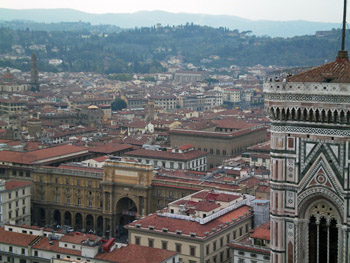 Recognizable to any medieval citizen, the Baptistery and Duomo remain the heart of Florence. Dante’s ‘bel San Giovanni’ is one of the city’s oldest and most famous buildings. Medieval houses still line the Piazza Duomo, many still proudly displaying a stone coat of arms. Like many Florentines of the time, Dante was baptized in the large octagonal font of the Basilica. The building itself dates back to the 4th century. The 13th century mosaics covering the ceiling show with graphic detail the horrors and glories of the Last Judgment. Dante never saw Ghiberti’s famed doors, for they would not grace the building for another century.
Recognizable to any medieval citizen, the Baptistery and Duomo remain the heart of Florence. Dante’s ‘bel San Giovanni’ is one of the city’s oldest and most famous buildings. Medieval houses still line the Piazza Duomo, many still proudly displaying a stone coat of arms. Like many Florentines of the time, Dante was baptized in the large octagonal font of the Basilica. The building itself dates back to the 4th century. The 13th century mosaics covering the ceiling show with graphic detail the horrors and glories of the Last Judgment. Dante never saw Ghiberti’s famed doors, for they would not grace the building for another century.
Construction of the Duomo began in 1296, before Dante’s exile in 1301. In the basement lie the excavations of the Paleochristian cathedral Santa Reperata, founded in the 6th or 7th century AD on the remains of a Roman palace. On the southern side, just before the Via dello Studio, is a stone plaque marking where the poet would sit and contemplate the construction of the cathedral.
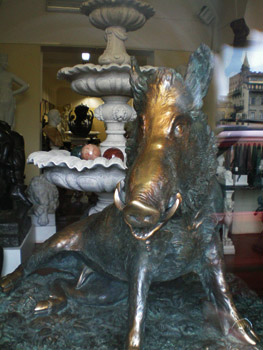 For the hardy, 463 steps lead from the floor of the Duomo and up through a labyrinth of corridors and stairwells to the top of the cupola. (The most difficult part of the climb is over the arch; there is a spot here for lovers to place a padlock and throw away the key. In hidden corners remain marks left on the brickwork by the medieval builders.) The cupola soars to the height of the neighbouring hills. The view embraces the history of Florence, with many a medieval street following the course of their Roman precursors. Private palaces survive, and a few towers – or torre, outlawed in 1250 – still remain.
For the hardy, 463 steps lead from the floor of the Duomo and up through a labyrinth of corridors and stairwells to the top of the cupola. (The most difficult part of the climb is over the arch; there is a spot here for lovers to place a padlock and throw away the key. In hidden corners remain marks left on the brickwork by the medieval builders.) The cupola soars to the height of the neighbouring hills. The view embraces the history of Florence, with many a medieval street following the course of their Roman precursors. Private palaces survive, and a few towers – or torre, outlawed in 1250 – still remain.
The Via de Calzaiuoli was the thoroughfare of the medieval city. Linking the Duomo to the Palazzo Vecchio, it runs past the all-important Guildhall of Orsanmichel. Once a grain hall, in Dante’s time the Orsanmichel reflected the power wielded by the greater guilds. The statues in the niches on the outside walls were commissioned by each guild. These include the Medici e Speciali, the guild of physicians, apothecaries and painters, to which Dante belonged. (Without guild membership, a Florentine could not participate in the city’s parlamentos.)
A slight detour leads to the Mercato Nuovo, popular since the 11th century. Locally it is known as il Porcellino after the bronze boar with a well-polished nose who takes pride of place at the entrance.
Via delle Terms
Heading west from the Mercato Nuovo leads to the Via delle Terms. Named after the Roman Baths once in the area, it remains an attractive medieval street. At its beginning stands the Casa Torre Buondelmonte. No. 9 is a medieval palace with a renaissance courtyard, while another torre remains at no. 13. The road opens into the Piazza Santa Trinita, with its tall Roman column taken from the Baths of Caracalla. A church has existed on this site since 1077.
Leading from the piazza and running parallel to the Arno is the Borgo Santi Apostoli. Like many Florentine streets it is originally Roman. In the Piazza del Limbo stands Santi Apostoli, which, like the Baptistry, is one of the oldest surviving churches in the city. A plaque claims it was founded by Charlemagne in 786. The age of the building can be seen in that it lies considerably lower than the road.
Beyond the Ponte Vecchio, the Via dei Neri bends as it follows the shape of the old Roman port. A small road branches off to the 11th century church San Remigio; tablets along the length of the road mark the height of both the 1333 and 1966 floods. The Via Dei Neri leads to the Palazzo dei Priori, renamed the Palazzo Vecchio in 1299.
 Dominating the Palazzo Vecchio, the Piazza della Signora has continued as the centre of political activity since the Middle Ages. Heavy traffic has been banned since 1385. The imposing façade of the Palazzo Vecchio has remained virtually unchanged since it was built (1299 – 1302) – Dante writes of how the houses of the Ghibelline Uberti were demolished after the triumph of the Guelfs, and the new Palazzo built on their ruins. (The Piazza della Signora is itself built over Roman ruins.)
Dominating the Palazzo Vecchio, the Piazza della Signora has continued as the centre of political activity since the Middle Ages. Heavy traffic has been banned since 1385. The imposing façade of the Palazzo Vecchio has remained virtually unchanged since it was built (1299 – 1302) – Dante writes of how the houses of the Ghibelline Uberti were demolished after the triumph of the Guelfs, and the new Palazzo built on their ruins. (The Piazza della Signora is itself built over Roman ruins.)
The Palazzo Vecchio still functions as the town hall. Its bell tower, once the tallest edifice in the city, summoned the (male) population to the parlomento in the square below in times of trouble. Savavarola was imprisoned in the Palazzo before being burnt at the stake in the Piazza della Signora. It was here, in 1530, the people of Florence proclaimed the return of the Medici from their own exile.
It is this area of Florence most associated with Dante. The Via dei Maggazini leads from the Piazza della Signora to the Via Dante Alighieri. In a restored 13th century tower house is the Casa di Dante, a museum dedicated to the poet’s life and works. A plaque in the small piazza lists the monuments existing in Dante’s time.
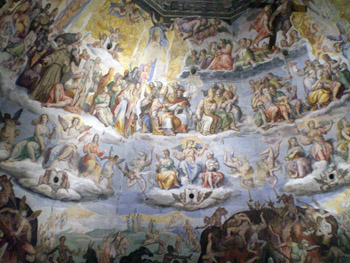 Walking beneath the arch into the Via Santa Margherita leads past the 12th century Santa Margherita de’ Cerchi, where the poet married Gemma Donati (they were betrothed when Dante was nine). It is also where he first saw Beatrice Portinari, the woman he immortalized in his writing. Beatrice’s father, Folco Portinari, is buried here.
Walking beneath the arch into the Via Santa Margherita leads past the 12th century Santa Margherita de’ Cerchi, where the poet married Gemma Donati (they were betrothed when Dante was nine). It is also where he first saw Beatrice Portinari, the woman he immortalized in his writing. Beatrice’s father, Folco Portinari, is buried here.
A few streets away is the Badia Florentina, whose bell, as mentioned in Paradiso (XV 97-98) regulated medieval life. Boccaccio used the Badia in 1373 to give public lectures on Dante’s works. Opposite is the Bargello, the oldest seat of government surviving in Florence. It was here that Dante’s banishment was proclaimed.
An archway leads from the piazza to the Via Proconsolo, where Beatrice lived. This street in turn opens onto the Corso, another Roman road, which leads to the site of the eastern gate of the Roman city; ‘Florentina’ was founded in 59 BC as a gift from Julius Caesar to his veterans.
The Ponte Vecchio
 Standing near the site of the original Roman crossing of the Arno, this was the city’s only bridge until 1218. In Dante’s time the Ponte Vecchio was home to butchers and grocers; since the 16th C it had been the place to shop Florence’s most spectacular jewellery.
Standing near the site of the original Roman crossing of the Arno, this was the city’s only bridge until 1218. In Dante’s time the Ponte Vecchio was home to butchers and grocers; since the 16th C it had been the place to shop Florence’s most spectacular jewellery.
Until the Grand Dukes move here in 1550, The Oltrarno, was literally ‘other side of the Arno’, where those who could not afford a grand palazzo within the city center lived. Today, it remains relatively quiet compared with the bustle of the city.
A walk of a few minutes from the Ponte Vecchio leads to Santa Felicita. A church has existed on this site since the 4th C. In the 2nd century AD some Syrian-Greek merchants settled along a busy consular road here, bringing Christianity to the city. Inside are some masterpieces of 16th century Florentine painting. The Vasari corridor runs through the nave, which enabled the Medici to attend Mass unseen by the great unwashed.
 On the left of the church runs the Costa di San Giorgio; Galileo once lived at No 9. At the end of the road stands the Porta San Giorgio, the oldest of the surviving city gates (Florence was still a wall city in Dante’s time.) A steep walk away is perhaps the most unspoilt of all the Romanesque churches in Tuscany: San Miniato al Monte. It’s classical façade of green-grey and white marble has looked down over Florence since 1018.
On the left of the church runs the Costa di San Giorgio; Galileo once lived at No 9. At the end of the road stands the Porta San Giorgio, the oldest of the surviving city gates (Florence was still a wall city in Dante’s time.) A steep walk away is perhaps the most unspoilt of all the Romanesque churches in Tuscany: San Miniato al Monte. It’s classical façade of green-grey and white marble has looked down over Florence since 1018.
The quiet streets of the Oltrarno are filled with artisan workshops and medieval buildings. Wandering them at leisure, perhaps with a gelato in hand, gives an insight into Florence in the time of Dante. Perhaps even better, why not imitate the locals and choose a place to enjoy a coffee with some schiacciata alla fiorentina, or maybe a glass of prosecco and some crostini, and sit and watch the world go by?
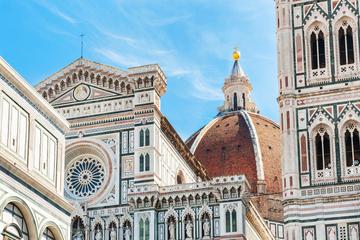
Private Renaissance Discovery Tour of Florence
If You Go:
♦ For a unique experience, consider a convent or monastery stay.
♦ www.fmmfirenze.it – Casa Santo Nome di Gesu: a 15th century palace in the Piazza del Carmine, now a Dominican convent
♦ www.sanctuarybbfirenze.com – Sanctuary B&B Firenze: an oasis a few streets away from the Duomo
♦ english.firenze.net – a website with useful accommodation and dining links
♦ www.firenzeturismo.it – the official tourism website, with English pages
♦ www.florence-tourism.com – an easily navigated site with useful resources
♦ www.uffizi.com – the official website of the Uffizi
♦ www.florence-museum.com – links to the city’s museums and galleries, with lists of upcoming exhibitions
About the author:
Anne Harrison lives with her husband, two children and numerous pets on the Central Coast, NSW. Her jobs include wife, mother, doctor, farmer and local witch doctor – covering anything from delivering alpacas to treating kids who have fallen head first into the washing machine. Her fiction has been published in Australian literary magazines, and has been placed in regional literary competitions. Her non-fiction has been published in medical and travel journals. Her ambition is to be 80 and happy. Her writings are available at anneharrison.com.au and anneharrison.hubpages.com.
All photos are by Anne Harrison:
The Duomo and Baptistery still tower over Florence
View across the Baptistery to the hills, showing many torre
A replica of il Porcilleno for sale
The dominance of the Palazzo Vecchio
The frescoes of the Baptistery were known to Dante
The Ponte Vecchio, symbol of Florence
Restoration of works continues in the back streets of the Oltrano


 As we stood outside the former monastic site at Glendalough, our guide, Joan, directed us to the 900-year old gateway and indicated that the original structure had two round-headed granite arches supporting a timber roof. This was the gateway to civilization at the time. The lands beyond the monastic settlement teamed with highwaymen and other dangers. I imagined terrified individuals running past us through the gate to reach the cross-inscribed stone set just inside on the right as Joan explained that Glendalough was a place of refuge. The so-called “Sanctuary Stone” defined the point of safety for those on the run. Once a refugee passed inside the gate beyond the stone, he/she was safe.
As we stood outside the former monastic site at Glendalough, our guide, Joan, directed us to the 900-year old gateway and indicated that the original structure had two round-headed granite arches supporting a timber roof. This was the gateway to civilization at the time. The lands beyond the monastic settlement teamed with highwaymen and other dangers. I imagined terrified individuals running past us through the gate to reach the cross-inscribed stone set just inside on the right as Joan explained that Glendalough was a place of refuge. The so-called “Sanctuary Stone” defined the point of safety for those on the run. Once a refugee passed inside the gate beyond the stone, he/she was safe. In the vicinity of the round tower, the remains of a cathedral, dedicated to St Peter and St Paul, consist of a 10th century nave and a 12th century chancel. The arch, once finely decorated, is constructed of limestone imported from Bristol, England. A wall cupboard and basin used for washing the sacred vessels used in the mass is still visible in the sacristy.
In the vicinity of the round tower, the remains of a cathedral, dedicated to St Peter and St Paul, consist of a 10th century nave and a 12th century chancel. The arch, once finely decorated, is constructed of limestone imported from Bristol, England. A wall cupboard and basin used for washing the sacred vessels used in the mass is still visible in the sacristy. The postcard-like view of the upper lake features green hills gently rolling into the water on your left and trees at the water’s edge on your right. Opposite you in the distance, a stream descends the mountain into the lake. This tranquil setting greeted St. Kevin almost 14 centuries ago.
The postcard-like view of the upper lake features green hills gently rolling into the water on your left and trees at the water’s edge on your right. Opposite you in the distance, a stream descends the mountain into the lake. This tranquil setting greeted St. Kevin almost 14 centuries ago. Walking on, you enter a grove of trees to find the derelict 11th century Reefert Church with its stone nave and chancel. This church was a major attraction for those on pilgrimage to Glendalough as St. Kevin’s relics were housed here after his death.
Walking on, you enter a grove of trees to find the derelict 11th century Reefert Church with its stone nave and chancel. This church was a major attraction for those on pilgrimage to Glendalough as St. Kevin’s relics were housed here after his death.
 Slowly Diane and I climbed to the summit of the 300-foot high limestone promontory known as the Rock of Cashel. At the top, we were rewarded with a panoramic view of the green fields of County Tipperary below and the town of Cashel at the base. Despite the presence of the town below, the rock feels isolated.
Slowly Diane and I climbed to the summit of the 300-foot high limestone promontory known as the Rock of Cashel. At the top, we were rewarded with a panoramic view of the green fields of County Tipperary below and the town of Cashel at the base. Despite the presence of the town below, the rock feels isolated. Set next to the round tower, you find the shell of the second cathedral on site, dating to 1235. The current gray stone structure is cruciform with a central tower. The nave, which was never completed, is shorter than the choir. The north transept houses three sarcophagi, dating the 16th century, each with carved bas reliefs of the apostles around the periphery. The Protestant Church of Ireland abandoned this cathedral in the mid 17th century and then had the roof removed to collect the lead for ammunition. The cathedral lacks a roof to this day.
Set next to the round tower, you find the shell of the second cathedral on site, dating to 1235. The current gray stone structure is cruciform with a central tower. The nave, which was never completed, is shorter than the choir. The north transept houses three sarcophagi, dating the 16th century, each with carved bas reliefs of the apostles around the periphery. The Protestant Church of Ireland abandoned this cathedral in the mid 17th century and then had the roof removed to collect the lead for ammunition. The cathedral lacks a roof to this day. Inside the chapel, you find a white vaulted ceiling with plaster fragments falling off. The whitewash, dating from the Reformation in the 16th century, was used to cover the oldest frescoes in Ireland including those of the Nativity. An intricately carved sarcophagus at the back of the chapel might possibly be that of King Cormac himself.
Inside the chapel, you find a white vaulted ceiling with plaster fragments falling off. The whitewash, dating from the Reformation in the 16th century, was used to cover the oldest frescoes in Ireland including those of the Nativity. An intricately carved sarcophagus at the back of the chapel might possibly be that of King Cormac himself.
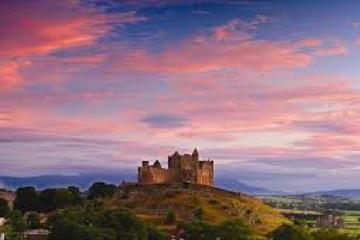



 On a previous visit to Paris, I had been soundly rebuked by an elderly French gentleman when I told him that I’d never visited Sainte-Chapelle, so on this visit I was determined to rectify my earlier omission. I’m so glad I took that gentleman’s advice, for Sainte Chapelle, with its glorious stained glass windows is a sight not to be missed.
On a previous visit to Paris, I had been soundly rebuked by an elderly French gentleman when I told him that I’d never visited Sainte-Chapelle, so on this visit I was determined to rectify my earlier omission. I’m so glad I took that gentleman’s advice, for Sainte Chapelle, with its glorious stained glass windows is a sight not to be missed.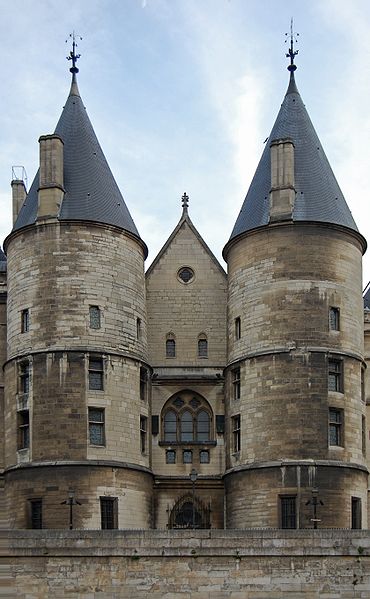 My next port of call, still in the same Palace of Justice complex, was the Conciergerie, on the west side of the island, facing the Quai d’Horlage. The Conciergerie takes its name from the post of the Concierge, a high-ranking official who was placed in command of the Palace of Justice when Charles V moved his royal palace to the Louvre. Part of the Palace was converted to a prison in 1391 and, over the centuries, criminals from all walks of life whiled away their miserable years in the dank cells. The Conciergerie is best remembered, however, for those imprisoned during the French Revolution, when citizens suspected of being counter-revolutionaries were incarcerated in the Conciergerie while they awaited their turn at the guillotine. The most famous prisoner of all was Marie Antoinette, wife of the ill-fated Louis XVI, who awaited her execution in a tiny cell, only separated from her guards’ constant surveillance, by a curtain drawn across half the cell.
My next port of call, still in the same Palace of Justice complex, was the Conciergerie, on the west side of the island, facing the Quai d’Horlage. The Conciergerie takes its name from the post of the Concierge, a high-ranking official who was placed in command of the Palace of Justice when Charles V moved his royal palace to the Louvre. Part of the Palace was converted to a prison in 1391 and, over the centuries, criminals from all walks of life whiled away their miserable years in the dank cells. The Conciergerie is best remembered, however, for those imprisoned during the French Revolution, when citizens suspected of being counter-revolutionaries were incarcerated in the Conciergerie while they awaited their turn at the guillotine. The most famous prisoner of all was Marie Antoinette, wife of the ill-fated Louis XVI, who awaited her execution in a tiny cell, only separated from her guards’ constant surveillance, by a curtain drawn across half the cell.
 The Ile Saint-Louis was originally called the “Island of the Cows” but was renamed in honour of Louis IX. The connecting bridge to the Ile de la Cité was completed around 1628 and a bridge to the mainland was built in 1635. Once access to the island was accomplished, building began in earnest – all the nouveau riche – the wealthy farmers, merchants and members of the bureaucracy – hurriedly bought land and built beautiful hôtels on the eastern half of the island. Development on the western side came later, where the houses were built in the same elegant design.
The Ile Saint-Louis was originally called the “Island of the Cows” but was renamed in honour of Louis IX. The connecting bridge to the Ile de la Cité was completed around 1628 and a bridge to the mainland was built in 1635. Once access to the island was accomplished, building began in earnest – all the nouveau riche – the wealthy farmers, merchants and members of the bureaucracy – hurriedly bought land and built beautiful hôtels on the eastern half of the island. Development on the western side came later, where the houses were built in the same elegant design.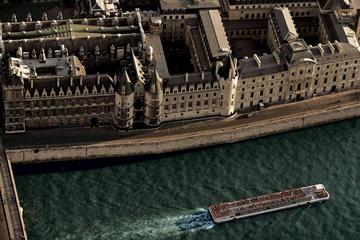

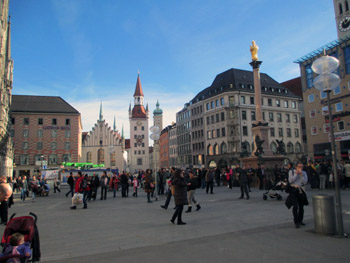
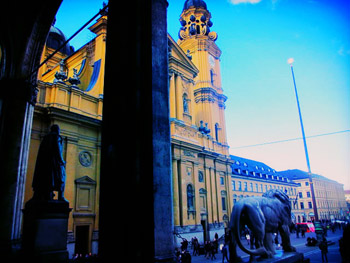 Instead of carrying around a thick guide book which forces visitors to stare down at the tiny print and flip pages, a great option for those seeking to learn about the war-related history is to sign up for Sandeman’s New Europe, Third Reich walking tour. For 12 euro, my journey through the dark history began at the center of the city, at the beautiful Marienplatz. Immediately, the tour guide, who was a walking treasure chest of knowledge instructed the group of 10-15 people to look up at our surroundings. After explaining how the majority of the area was completely bombed out during World War II, he pointed to the main spires of the Marienplatz, and the giant green domes from the Frauenkirche. He explained how the bomber jets from the allied forces used them as landmarks in their bombing campaign, therefore they were spared and remained mostly intact. Chills immediately shot down my spine, as I felt the realness in which surrounded me. This was real, and these were not events which took place in the Dark Ages; this was a time that our close relatives could have lived through. It was a time in which the desperation of the German people gave way to the rise of a former painter from Austria, and allowed Adolf Hitler to guide his people, and the world into a conflict that took the lives of nearly 85 million people.
Instead of carrying around a thick guide book which forces visitors to stare down at the tiny print and flip pages, a great option for those seeking to learn about the war-related history is to sign up for Sandeman’s New Europe, Third Reich walking tour. For 12 euro, my journey through the dark history began at the center of the city, at the beautiful Marienplatz. Immediately, the tour guide, who was a walking treasure chest of knowledge instructed the group of 10-15 people to look up at our surroundings. After explaining how the majority of the area was completely bombed out during World War II, he pointed to the main spires of the Marienplatz, and the giant green domes from the Frauenkirche. He explained how the bomber jets from the allied forces used them as landmarks in their bombing campaign, therefore they were spared and remained mostly intact. Chills immediately shot down my spine, as I felt the realness in which surrounded me. This was real, and these were not events which took place in the Dark Ages; this was a time that our close relatives could have lived through. It was a time in which the desperation of the German people gave way to the rise of a former painter from Austria, and allowed Adolf Hitler to guide his people, and the world into a conflict that took the lives of nearly 85 million people.
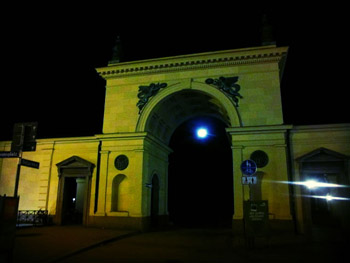 Walking through the streets of the 1,000-year-old city would lead most to believe that the surrounding buildings go back hundreds of years, but they would be greatly mistaken. Following the rise of Adolf Hitler in the early 1930s, Munich became the birthplace of the Nazi Party, and eventually one of the biggest targets for the allies during World War II. The result was thousands of bombs being droppedtact on the city, and to this day, an estimated 2,000 un-detonated bombs are still buried beneath the city. Since nearly 90 percent of the city was completely demolished, everything has been rebuilt, and reconstructed in the 70 years since to end of the war. While construction continues in the Bavarian capital, bombs are still discovered on a weekly basis, and teams have to come in to safely detonate the bombs which range anywhere from 4 lbs to 22,000 lbs. Our tour guide told stories how entire street blocks have to be closed, and entire apartment complexes cleared out when one is discovered. Life goes on, and the residents of Munich accept it as if it is nothing more than a minor inconvenience.
Walking through the streets of the 1,000-year-old city would lead most to believe that the surrounding buildings go back hundreds of years, but they would be greatly mistaken. Following the rise of Adolf Hitler in the early 1930s, Munich became the birthplace of the Nazi Party, and eventually one of the biggest targets for the allies during World War II. The result was thousands of bombs being droppedtact on the city, and to this day, an estimated 2,000 un-detonated bombs are still buried beneath the city. Since nearly 90 percent of the city was completely demolished, everything has been rebuilt, and reconstructed in the 70 years since to end of the war. While construction continues in the Bavarian capital, bombs are still discovered on a weekly basis, and teams have to come in to safely detonate the bombs which range anywhere from 4 lbs to 22,000 lbs. Our tour guide told stories how entire street blocks have to be closed, and entire apartment complexes cleared out when one is discovered. Life goes on, and the residents of Munich accept it as if it is nothing more than a minor inconvenience. Prior to the air-raids by allied troops, Adolf Hitler was well aware that Munich would be a major target, and knew the city would be leveled. Planning ahead, he ordered photos be taken throughout the city, so that when the war ended, the city could be built exactly as it was prior to its near destruction. Following the death of Hitler and the fall of the Nazi’s, the German people voted to restore the city to its old glory, resulting in a complete rebuild. Since everything has been rebuilt, it gives visitors a unique perspective roaming the streets, and ducking into beer halls and cafes that fill the city. While the history is thick, and I could nearly feel it hanging in the air, it also felt like stepping into a movie set. Along the guided tour, we were taken to places of historical significance, such as the world-famous Hofbräuhaus. We were taken upstairs into the beautiful beer hall, and shown the place where the Nazi leader once spoke. However, the reality is that the building is a complete replication of the original, somewhat taking away some of the powerfulness which stood before me. It is fascinating, yet saddening how such beautiful architecture and sights were destroyed, but in spite of the restoration, there is still the ghost of the German dictator that echoes throughout the halls.
Prior to the air-raids by allied troops, Adolf Hitler was well aware that Munich would be a major target, and knew the city would be leveled. Planning ahead, he ordered photos be taken throughout the city, so that when the war ended, the city could be built exactly as it was prior to its near destruction. Following the death of Hitler and the fall of the Nazi’s, the German people voted to restore the city to its old glory, resulting in a complete rebuild. Since everything has been rebuilt, it gives visitors a unique perspective roaming the streets, and ducking into beer halls and cafes that fill the city. While the history is thick, and I could nearly feel it hanging in the air, it also felt like stepping into a movie set. Along the guided tour, we were taken to places of historical significance, such as the world-famous Hofbräuhaus. We were taken upstairs into the beautiful beer hall, and shown the place where the Nazi leader once spoke. However, the reality is that the building is a complete replication of the original, somewhat taking away some of the powerfulness which stood before me. It is fascinating, yet saddening how such beautiful architecture and sights were destroyed, but in spite of the restoration, there is still the ghost of the German dictator that echoes throughout the halls.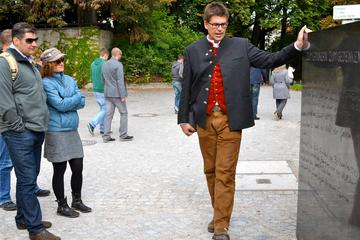
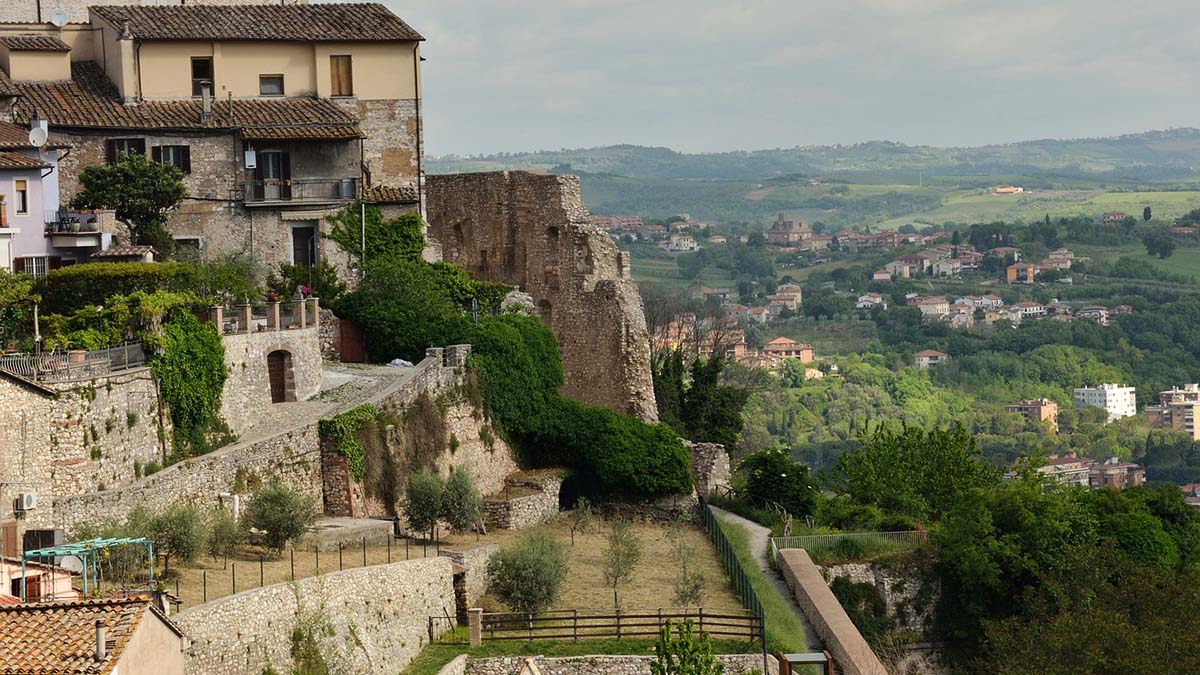
 The delightful medieval town of Narni in Umbria would perhaps have gone almost unnoticed, apart from being considered to be the exact geographical centre of Italy, if it hadn’t been for C.S.Lewis. While examining a Latin atlas of Europe, he came across the name Narnia, which soon took on a whole new meaning. Although Lewis never visited Narnia, or Narni, as it is now known, it may not be pure coincidence that the tomb of Blessed Lucy of Narni can be found in the town’s impressive cathedral. Images of mythical beasts in stone and iron decorate the ancient buildings and streets. The lion features prominently.
The delightful medieval town of Narni in Umbria would perhaps have gone almost unnoticed, apart from being considered to be the exact geographical centre of Italy, if it hadn’t been for C.S.Lewis. While examining a Latin atlas of Europe, he came across the name Narnia, which soon took on a whole new meaning. Although Lewis never visited Narnia, or Narni, as it is now known, it may not be pure coincidence that the tomb of Blessed Lucy of Narni can be found in the town’s impressive cathedral. Images of mythical beasts in stone and iron decorate the ancient buildings and streets. The lion features prominently. Guided tours of Narni Underground nowadays begin in the church, which was consecrated as “Santa Maria delle Rupe”, although the discovery of a copy of a fourteenth century contract revealed the church’s original name as being Chiesa di Sant’Angelo or S. Michele Archangelo (St Michael The Archangel). Although the church has sustained considerable damage, due to water infiltration, beautiful frescos of Christ on the Cross and symbols of the evangelists still adorn the walls and the ceiling is painted with stars and a symbol of The Lamb of God. The Archangel Michael features fighting a dragon and weighing souls. Several skeletons were found in tombs in the floor of the church, which has still not been completely excavated.
Guided tours of Narni Underground nowadays begin in the church, which was consecrated as “Santa Maria delle Rupe”, although the discovery of a copy of a fourteenth century contract revealed the church’s original name as being Chiesa di Sant’Angelo or S. Michele Archangelo (St Michael The Archangel). Although the church has sustained considerable damage, due to water infiltration, beautiful frescos of Christ on the Cross and symbols of the evangelists still adorn the walls and the ceiling is painted with stars and a symbol of The Lamb of God. The Archangel Michael features fighting a dragon and weighing souls. Several skeletons were found in tombs in the floor of the church, which has still not been completely excavated. Convinced there was still more to discover, in May 1979, the young potholers, whose efforts to draw attention to their discovery were largely ignored, found a blocked up door in a garden on the other side of the wall. Being denied permission to try and open the door, the friends took advantage of boisterous festivities, during the local medieval celebration the “Corsa all’Anello”, to cover noise while they made a hole in the door. They were stunned by what they discovered. A short passage led to a large windowless chamber, which later came to light had been used by The Court of the Inquisition to “extract” confessions from those accused of polygamy, blasphemy, witchcraft and adultery- crimes which labelled them as heretics. “The Room of Torment” now contains models of gruesome torture instruments used on these ill-fated souls, including the rack and Judas cradle. Beyond the chamber, the group came across a tiny cell, completely covered in mysterious graffiti. The inscription “Santo Uffizio” (Holy Office), was the key to leading them to understand the area had been used by The Inquisition.
Convinced there was still more to discover, in May 1979, the young potholers, whose efforts to draw attention to their discovery were largely ignored, found a blocked up door in a garden on the other side of the wall. Being denied permission to try and open the door, the friends took advantage of boisterous festivities, during the local medieval celebration the “Corsa all’Anello”, to cover noise while they made a hole in the door. They were stunned by what they discovered. A short passage led to a large windowless chamber, which later came to light had been used by The Court of the Inquisition to “extract” confessions from those accused of polygamy, blasphemy, witchcraft and adultery- crimes which labelled them as heretics. “The Room of Torment” now contains models of gruesome torture instruments used on these ill-fated souls, including the rack and Judas cradle. Beyond the chamber, the group came across a tiny cell, completely covered in mysterious graffiti. The inscription “Santo Uffizio” (Holy Office), was the key to leading them to understand the area had been used by The Inquisition. The graffiti in the prison cell appears to have largely been the work of one desperate prisoner, Giuseppe Andrea Lombardini, whose name is inscribed on the wall under the date 1759 and the remains of the word “Innocent”, which was erased by his guards. Lombardini left a series of cryptic messages and mysterious symbols ,made from a mixture of brick dust and urine, that seem to have a peculiar mixture of origins. Masonic symbols, such as a triangle with a dot, symbolising the eye of the Grand Architect of the Universe merge with strong Christian symbols such as crosses, religious monograms and a representation of the legend of St Nicolas. An image of a tree surrounded by doves is thought to symbolize the tree of life. A sinister falconer catching birds under the tree may represent the church, or the Inquistion itself, destroying freedom. The sequence 7, 24, 42, 70 is repeated in 3 areas within the cell. The sum of the interior numbers is 66, whereas that of the exterior numbers is 77, therefore implying the battle between good and evil. It is interesting to note that the graffiti artist deliberately replaces the letter D with the letter T in his inscriptions, which is believed to express hatred for the Dominican order who ran the Inquisition. Suns, moons, ladders, Jesuit and cabalistic images leave secret messages that have still not been completely deciphered.
The graffiti in the prison cell appears to have largely been the work of one desperate prisoner, Giuseppe Andrea Lombardini, whose name is inscribed on the wall under the date 1759 and the remains of the word “Innocent”, which was erased by his guards. Lombardini left a series of cryptic messages and mysterious symbols ,made from a mixture of brick dust and urine, that seem to have a peculiar mixture of origins. Masonic symbols, such as a triangle with a dot, symbolising the eye of the Grand Architect of the Universe merge with strong Christian symbols such as crosses, religious monograms and a representation of the legend of St Nicolas. An image of a tree surrounded by doves is thought to symbolize the tree of life. A sinister falconer catching birds under the tree may represent the church, or the Inquistion itself, destroying freedom. The sequence 7, 24, 42, 70 is repeated in 3 areas within the cell. The sum of the interior numbers is 66, whereas that of the exterior numbers is 77, therefore implying the battle between good and evil. It is interesting to note that the graffiti artist deliberately replaces the letter D with the letter T in his inscriptions, which is believed to express hatred for the Dominican order who ran the Inquisition. Suns, moons, ladders, Jesuit and cabalistic images leave secret messages that have still not been completely deciphered. In 2004, it was discovered that Trinity College, Dublin housed a number of important documents referring to the Inquisition including transcripts of the trial of Domenico Ciabocchi, confirming the existence of The Inquisition in Narni. Following this discovery, Robert Nini, one of the intrepid potholers and now president of Narni Underground, wrote to Cardinal Ratzinger (later Pope Benedict XIV) who granted him permission to consult the secret archives in the Vatican.
In 2004, it was discovered that Trinity College, Dublin housed a number of important documents referring to the Inquisition including transcripts of the trial of Domenico Ciabocchi, confirming the existence of The Inquisition in Narni. Following this discovery, Robert Nini, one of the intrepid potholers and now president of Narni Underground, wrote to Cardinal Ratzinger (later Pope Benedict XIV) who granted him permission to consult the secret archives in the Vatican.


